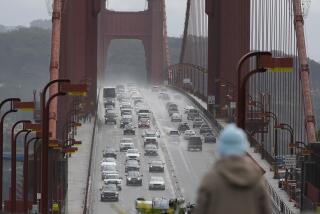Radar Device May Help Avert Auto Crashes : U.S. Approval Comes 30 Years After Invention
- Share via
WASHINGTON — Driving home one night through dense fog, George Rashid pulled over to the side of the road and decided that if airplanes use radar, automobiles could use it too.
More than 30 years later, his sons have received government approval for their late father’s invention--a radar device designed to warn car and truck drivers of possible front-end collisions.
The Rashid Radar Collision Warning System uses radar to detect an object in the path of a vehicle and a microprocessor to determine whether a collision is imminent. If an automobile is closing in on a slower or stationary object, the system flashes a series of warning lights and sounds a siren until the driver hits the brakes.
The Federal Communications Commission has approved the system for use after three years of testing that covered more than a million miles, Jack Rashid said last week. Rashid is vice president for marketing of Vehicle Radar Safety Systems Inc., the family-owned company that developed the system.
The Rashid family hopes the invention will “contribute to safety on the nation’s highways,” he said.
Front-End Collisions
About 55% of all people killed while driving or riding in a motor vehicle lose their lives in front-end collisions, according to the National Highway Traffic Safety Administration. In 1984, about 11,500 car occupants died in front-end collisions, and about 14,500 died in front-end collisions while riding in a car, truck, motorcycle or other motor vehicle, a NHTSA spokesman said.
Vehicle Radar also sees the warning system as the first step toward a radar brake system, which would both detect an imminent collision and activate the brakes. The company, based in Mount Clemens, Mich., has already developed a radar brake system but has not yet applied for FCC approval. The company will wait to see how the warning system does first, said Penny Farthing, company counsel.
The company had no estimates of potential sales, but said it believes it is ahead of any competition because it has a patented system with FCC approval, Rashid said.
The three-part warning system consists of a radar antenna, an electronic signal processor and a dashboard monitor.
The microwave radar antenna, when installed, looks like a third headlight above the front bumper of the car and acts as both a radar emitter and receiver. It sends out a narrow beam signal directly in front of the car, which bounces back to the antenna after hitting a slower moving vehicle or stationary object, as high or higher than the antenna. The beam misses objects to the side of the car, as well as road signs and overpasses, Rashid said.
Instant Evaluation
When the radar beam bounces back, the signal processor analyzes it to determine the speed and distance of the object, compared with the speed of the car using the radar system. The processor, a small box weighing less than five pounds, instantly evaluates the information to determine if a crash is possible.
The processor may then send a variety of signals to a small monitor placed on the dashboard. A green light indicates that the radar system is on. A yellow light alerts the driver that a slower or stationary object lies ahead. A red warning light and alarm sound tells a driver to cut speed, and another red light and shriller alarm says to hit the brakes.
The system is only activated at speeds above 10 mph, to avoid triggering the warnings when driving in bumper-to-bumper traffic or in a garage, said Charles Rashid, vice president of engineering.
It does, however, trigger radar detecting devices used by some motorists to warn them of police radar surveillance, Jack Rashid said.





